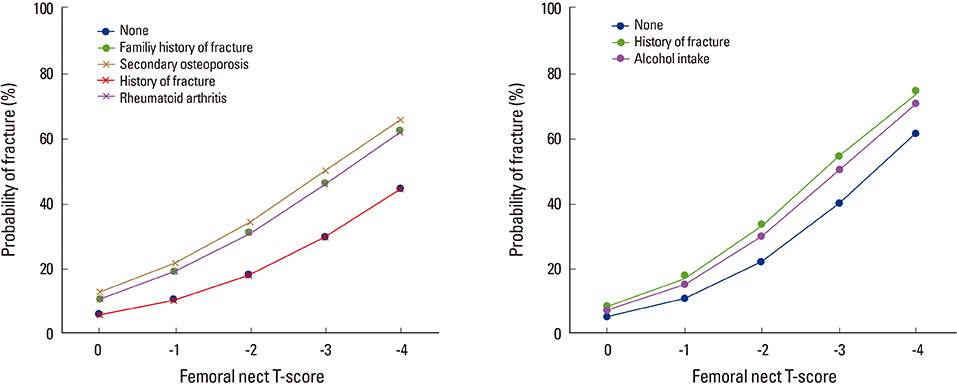J Bone Metab.
2016 Feb;23(1):34-39. 10.11005/jbm.2016.23.1.34.
Osteoporotic Fracture Risk Assessment Using Bone Mineral Density in Korean: A Community-based Cohort Study
- Affiliations
-
- 1Department of Information Statistics, Andong National University, Andong, Korea.
- 2Department of Orthopaedic Surgery, Seoul National University Bundang Hospital, Seongnam, Korea.
- 3Department of Anatomy, Seoul National University College of Medicine, Seoul, Korea.
- 4Department of Orthopaedic Surgery, School of Medicine, Chung-Ang University College of Medicine, Seoul, Korea. hayongch@naver.com
- 5College of Pharmacy, Gachon University, Incheon, Korea. smjang@gachon.ac.kr
- 6Department of Internal Medicine, Seoul National University College of Medicine, Seoul, Korea. csshin@snu.ac.kr
- 7Department of Preventive Medicine, Ajou University School of Medicine, Suwon, Korea. chnaha@ajou.ac.kr
- KMID: 2156285
- DOI: http://doi.org/10.11005/jbm.2016.23.1.34
Abstract
- BACKGROUND
Fracture-risk assessment tool (FRAX) using just clinical risk factors of osteoporosis has been developed to estimate individual risk of osteoporotic fractures. We developed prediction model of fracture risk using bone mineral density (BMD) as well as clinical risk factors in Korean, and assessed the validity of the final model.
METHODS
To develop and validate an osteoporotic FRAX, a total of 768 Korean men and women aged 50 to 90 years were followed for 7 years in a community-based cohort study. BMD as well as clinical risk factors for osteoporotic fracture including age, sex, body mass index, history of fragility fracture, family history of fracture, smoking status, alcohol intake, use of oral glucocorticoid, rheumatoid arthritis, and other causes of secondary osteoporosis were assessed biannually.
RESULTS
During the follow-up period, 86 osteoporotic fractures identified (36 in men and 50 in women). The developed prediction models showed high discriminatory power and had goodness of fit.
CONCLUSIONS
The developed a Korean specific prediction model for osteoporotic fractures can be easily used as a screening tool to identify individual with high risk of osteoporotic fracture. Further studies for validation are required to confirm the clinical feasibility in general Korean population.
Keyword
MeSH Terms
Figure
Cited by 1 articles
-
Association between Hemoglobin Level and Bone Mineral Density in Korean Adults
Yun Hwan Oh, Ji Hyun Moon, Belong Cho
J Bone Metab. 2017;24(3):161-173. doi: 10.11005/jbm.2017.24.3.161.
Reference
-
1. Peck WA, Burckhardt P, Christiansen C, et al. Consensus development conference: diagnosis, prophylaxis, and treatment of osteoporosis. Am J Med. 1993; 94:646–650.
Article2. Kang BJ, Lee YK, Lee KW, et al. Mortality after hip fractures in nonagenarians. J Bone Metab. 2012; 19:83–86.
Article3. Yoon HK, Park C, Jang S, et al. Incidence and mortality following hip fracture in Korea. J Korean Med Sci. 2011; 26:1087–1092.
Article4. Lee YK, Jang S, Jang S, et al. Mortality after vertebral fracture in Korea: analysis of the National Claim Registry. Osteoporos Int. 2012; 23:1859–1865.5. Park C, Ha YC, Jang S, et al. The incidence and residual lifetime risk of osteoporosis-related fractures in Korea. J Bone Miner Metab. 2011; 29:744–751.
Article6. Johnell O, Kanis JA, Oden A, et al. Predictive value of BMD for hip and other fractures. J Bone Miner Res. 2005; 20:1185–1194.
Article7. Lim LS, Hoeksema LJ, Sherin K, et al. Screening for osteoporosis in the adult U.S. population: ACPM position statement on preventive practice. Am J Prev Med. 2009; 36:366–375.8. Cadarette SM, Jaglal SB, Kreiger N, et al. Development and validation of the Osteoporosis Risk Assessment Instrument to facilitate selection of women for bone densitometry. CMAJ. 2000; 162:1289–1294.9. Salaffi F, Silveri F, Stancati A, et al. Development and validation of the osteoporosis prescreening risk assessment (OPERA) tool to facilitate identification of women likely to have low bone density. Clin Rheumatol. 2005; 24:203–211.
Article10. Middleton RG, Shabani F, Uzoigwe CE, et al. FRAX and the assessment of the risk of developing a fragility fracture. J Bone Joint Surg Br. 2012; 94:1313–1320.
Article11. Min YK, Lee DY, Park YS, et al. A FRAX Experience in Korea: fracture risk probabilities with a country-specific versus a surrogate model. J Bone Metab. 2015; 22:113–118.
Article12. Barrett-Connor E, Siris ES, Wehren LE, et al. Osteoporosis and fracture risk in women of different ethnic groups. J Bone Miner Res. 2005; 20:185–194.
Article13. STAT-Korea. Census 2000. 2001. cited by 2016 Feb 26. Available from: http://www.kosis.kr.14. Shin C, Abbott RD, Lee H, et al. Prevalence and correlates of orthostatic hypotension in middle-aged men and women in Korea: the Korean Health and Genome Study. J Hum Hypertens. 2004; 18:717–723.
Article15. Han JH, Park HS, Kim JA, et al. Apolipoprotein B is a better marker than non-HDL-cholesterol for the metabolic syndrome in Koreans. Atherosclerosis. 2008; 197:333–338.
Article16. Hung LK, Wu HT, Leung PC, et al. Low BMD is a risk factor for low-energy Colles' fractures in women before and after menopause. Clin Orthop Relat Res. 2005; 219–225.
Article17. Siris ES, Miller PD, Barrett-Connor E, et al. Identification and fracture outcomes of undiagnosed low bone mineral density in postmenopausal women: results from the National Osteoporosis Risk Assessment. JAMA. 2001; 286:2815–2822.
Article18. Cawthon PM, Ewing SK, Mackey DC, et al. Change in hip bone mineral density and risk of subsequent fractures in older men. J Bone Miner Res. 2012; 27:2179–2188.
Article19. Lau EM, Woo J, Leung PC, et al. Low bone mineral density, grip strength and skinfold thickness are important risk factors for hip fracture in Hong Kong Chinese. Osteoporos Int. 1993; 3:66–70.
Article20. Kanis JA, Johnell O, De Laet C, et al. International variations in hip fracture probabilities: implications for risk assessment. J Bone Miner Res. 2002; 17:1237–1244.
Article21. Kanis JA, Odén A, McCloskey EV, et al. A systematic review of hip fracture incidence and probability of fracture worldwide. Osteoporos Int. 2012; 23:2239–2256.
Article
- Full Text Links
- Actions
-
Cited
- CITED
-
- Close
- Share
- Similar articles
-
- Diffrences of Bone Mineral Density between Osteoporotic Group with or without Compression Fracture of the Spine
- Potential Biomarkers to Improve the Prediction of Osteoporotic Fractures
- Diabetes Mellitus and Osteoporosis
- Measurement of bone mineral density in osteoporotic fracture of the spine using dual energy X-ray absorptiometry
- Risk Factors for Subsequent Fracture after Osteoporotic Vertebral Compression Fracture


